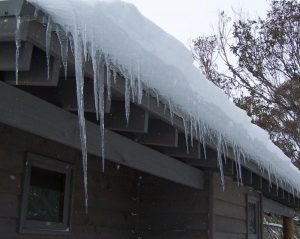Caring for Your Home During and After a Big Snow Storm
 1) If you have an exterior basement walkout that has several or many steps up to grade, it is critical to make sure the drain at the bottom of the stairs is clean. If the drain is covered with leaves and snow it may not drain fast enough to prevent water from flooding into the basement. At a minimum clear the drain. Even better would be to shovel out the basement walkup.
1) If you have an exterior basement walkout that has several or many steps up to grade, it is critical to make sure the drain at the bottom of the stairs is clean. If the drain is covered with leaves and snow it may not drain fast enough to prevent water from flooding into the basement. At a minimum clear the drain. Even better would be to shovel out the basement walkup.
2) Another unfortunate event that occurs in relation to the basement walkout is that, as the snow on the roof melts, it often runs over the gutter and into a walkout below (because the gutters and downspouts have not completely thawed). Not much you can do here except to keep your walkout drain clear.
3) Sump pump: If you have a sump pump make sure you shovel a trough or path through the snow for water that is being ejected by the sump pump to drain away from the house. At least 10 – 15 feet away from the house should do it.
4) Downspouts: Like sump pumps above you need to allow the water a place to run. Snow is likely to melt more quickly on the roof than on the ground next to the house. The un-melted snow on the ground can act like a dam preventing melting roof water from adequately draining away from the house. Don’t let it melt, come down the downspout and then have no where to go except against your foundation and maybe into your basement. Your action here would be to dig a path or trough in the snow from the bottom of your downspout away from your house.
*5) Ice dams: I’ll spare the building science lesson here on why ice dams occur (try Googling “Ice Dams” for the reasons). First sign of an ice dam is icicles hanging from the house gutters – this is not always a sign of ice dams – but more times than not the icicles are result of an ice dam. Here’s what’s happening: The snow on the roof above a warm attic is melting. The snow that is against the roof shingles melts because the attic is above freezing temperature. As the melting water runs down the roof and beyond the vertical plane of the exterior wall the water encounters the cold, below freezing, temperatures in the gutters or along the eves. The water re-freezes in the gutter or at the eve. The ice buildup in the gutter or eve can be significant enough to create a dam that forces the melting water into the house – it typically shows up as wet drywall on the exterior walls or ceiling and sometimes icicles on the exterior siding. Sometimes the first sign is that the interior wall paint on exterior walls looks like it is melting. The dams can often be significant enough that their weight tears the gutters off the house. BTW Ice dams typically occur in our area when we have deep snow accumulation on roofs of 8″+.
Here’s what to do:
- In the rooms that are exhibiting water penetration you need to close off heat registers so the room temperature drops. Goal is to get the room cold. Ideally close off heat registers to top floor BUT don’t let it get so cold that pipes freeze.
- If you notice what looks like a “bubble” in the ceiling paint, place a bucket under the “bubble” and poke a hole (screw driver is ideal for this) through the bubble and ceiling drywall so water has a place to drain. Monitor the bucket. Turn off lights and unplug all electric in that room.
- Removal of snow from the roof is the best solution to stopping the flow of water into the house. Some roofing and gutter companies offer this service.
- In really desperate situations a solution is to tear the gutters off the house as the ice dam progresses. This is a dangerous, difficult process and should not be attempted by most owners.
- Figure out how to make your attic colder while the ice dam is happening (so that the melting stops). Maybe hang a fan in the attic blowing out of an attic vent to remove the warm air. Don’t forget to close the attic access hatch or you will just pull more warm air into the attic and magnify the problem.
- Your options are limited when an ice dam happens. The best defense is preparation so an ice dam does not occur. I’ll write about this in the future.
6) If you have a heat pump, as many people in our area do, it is critical to keep at least a 2′ space around the outdoor heat pump unit shoveled clean as the snow begins to accumulate. By doing this you will reduce your chances of damage to the unit from accumulating snow that clogs the outdoor heat exchanger. If the outdoor unit gets buried due to deep or drifting snow, switch the unit over to Emergency Heat. Typically your indoor thermostat has a setting or switch to put your heat pump into Emergency Heat mode.







